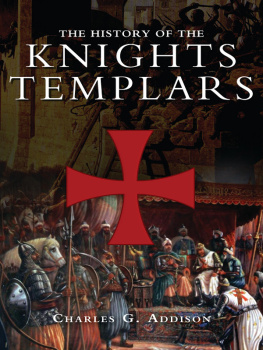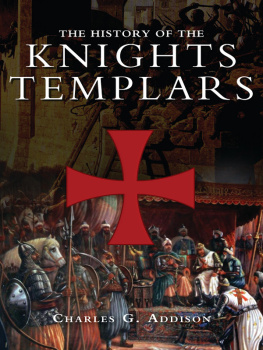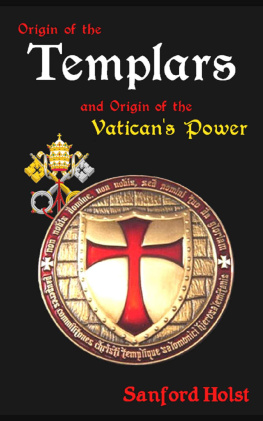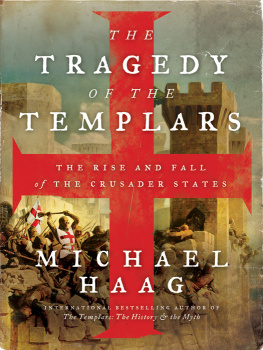THE HISTORY
OF
The Knights Templars
BY CHARLES G. ADDISON


Skyhorse Publishing
The Red Cross Knights

And on his brest a bloodie crosse he bore
The deare remembrance of his dying Lord
For whose sweete sake that glorious badge he bore
And dead (as living) ever him adord
Upon his shield the like was also scord
For sovereign hope which in his helpe he had;
Right faithful true he was in deed and word;
But of his cheer did seem to solemn sad
Yet nothing did he dread but ever was ydrad.
Faerie Queen

The ancient inscription on the Temple Church as it stood over the door
leading into the cloister.
TO THE
MASTERS OF THE BENCH OF THE HONOURABLE SOCIETIES
OF THE
Inner and Middle Temple,
THE RESTORERS
OF
The Ancient Church of the Knights Templars,
THIS WORK
IS
RESPECTFULLY DEDICATED
BY
THE AUTHOR.
PREFACE

THE extraordinary and romantic career of the Knights Templars, their exploits and their misfortunes, render their history a subject of peculiar interest.
Born during the first fervour of the Crusades, they were flattered and aggrandized as long as their great military power and religious fanaticism could be made available for the support of the Eastern church and the retention of the Holy Land, but when the crescent had ultimately triumphed over the cross, and the religio-military enthusiasm of Christendom had died away, they encountered the basest ingratitude in return for the services they had rendered to the Christian faith, and were plundered, persecuted, and condemned to a cruel death, by those who ought in justice to have been their defenders and supporters. The memory of these holy warriors is embalmed in all our recollections of the wars of the cross; they were the bulwarks of the Latin kingdom of Jerusalem during the short period of its existence, and were the last band of Europes host that contended for the possession of Palestine.
To the vows of the monk and the austere life of the convent, the Templars added the discipline of the camp, and the stern duties of the military life, joining
The fine vocation of the sword and lance,
With the gross aims, and body-bending toil
Of a poor brotherhood, who walk the
earth Pitied.
The vulgar notion that the Templars were as wicked as they were fearless and brave, has not yet been entirely exploded; but it is hoped that the copious account of the proceedings against the Order in this country, given in the ninth and tenth chapters of the ensuing volume, will tend to dispel many unfounded prejudices still entertained against the fraternity, and excite emotions of admiration for their constancy and courage, and of pity for their unmerited and cruel fate.
Matthew Paris, who wrote at St. Albans, concerning events in Palestine, tells us that the emulation between the Templars and Hospitallers frequently broke out into open warfare to the great scandal and prejudice of Christendom, and that, in a pitched battle fought between them, the Templars were slain to a man. The solitary testimony of Matthew Paris, who was no friend to the two orders, is invalidated by the silence of contemporary historians, who wrote on the spot; and it is quite evident from the letters of the pope, addressed to the Hospitallers, the year after the date of the alleged battle, that such an occurrence never could have taken place.
The accounts, even of the best of the ancient writers, should not be adopted without examination, and a careful comparison with other sources of information. William of Tyre, for instance, tells us that Nassr-ed-deen, son of sultan Abbas, was taken prisoner by the Templars, and whilst in their hands became a convert to the Christian religion; that he had learned the rudiments of the Latin language, and earnestly sought to be baptized, but that the Templars were bribed with sixty thousand pieces of gold to surrender him to his enemies in Egypt, where certain death awaited him; and that they stood by to see him bound hand and foot with chains, and placed in an iron cage, to be conducted across the desert to Cairo. Now the Arabian historians of that period tell us that Nassr-ed-deen and his father murdered the caliph and threw his body into a well, and then fled with their retainers and treasure into Palestine; that the sister of the murdered caliph wrote immediately to the commandant at Gaza, which place was garrisoned by the Knights Templars, offering a handsome reward for the capture of the fugitives; that they were accordingly intercepted, and Nassr-ed-deen was sent to Cairo, where the female relations of the caliph caused his body to be cut into small pieces in the seraglio. The above act has constantly been made a matter of grave accusation against the Templars; but what a different complexion does the case assume on the testimony of the Arabian authorities!
It must be remembered that William archbishop of Tyre was hostile to the Order on account of its vast powers and privileges, and carried his complaints to a general council of the church at Rome. He is abandoned, in everything that he says to the prejudice of the fraternity, by James of Vitry, bishop of Acre, a learned and most talented prelate, who wrote in Palestine subsequently to William of Tyre, and has copied largely from the history of the latter. The bishop of Acre speaks of the Templars in the highest terms, and declares that they were universally loved by all men for their piety and humility. Nulli molesti erant! says he, sed ab omnibus propter humilitatem et religionem amabantur?
The celebrated orientalist Von Hammer has recently brought forward various extraordinary and unfounded charges, destitute of all authority, against the Templars; and Wilcke, who has written a German history of the Order, seems to have imbibed all the vulgar prejudices against the fraternity. I might have added to the interest of the ensuing work, by making the Templars horrible and atrocious villains; but I have endeavoured to write a fair and impartial account of the Order, not slavishly adopting everything I find detailed in ancient writers, but such matters only as I believe, after a careful examination of the best authorities, to be true.
It is a subject of congratulation to us that we possess, in the Temple Church at London, the most beautiful and perfect memorial of the Order of the Knights Templars now in existence. No one who has seen that building in its late dress of plaster and whitewash will recognize it when restored to its ancient magnificence. This venerable structure was one of the chief ecclesiastical edifices of the Knights Templars in Europe, and stood next in rank to the Temple at Jerusalem. As I have performed the pilgrimage to the Holy City, and wandered amid the courts of the ancient Temple of the Knights Templars on Mount Moriah, I could not but regard with more than ordinary interest the restoration by the societies of the Inner and the Middle Temple of their beautiful Temple Church.
The greatest zeal and energy have been displayed by them in that praiseworthy undertaking, and no expense has been spared to repair the ravages of time, and to bring back the structure to

















